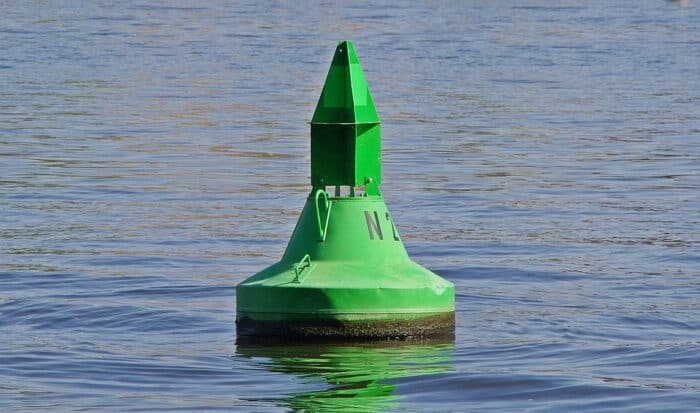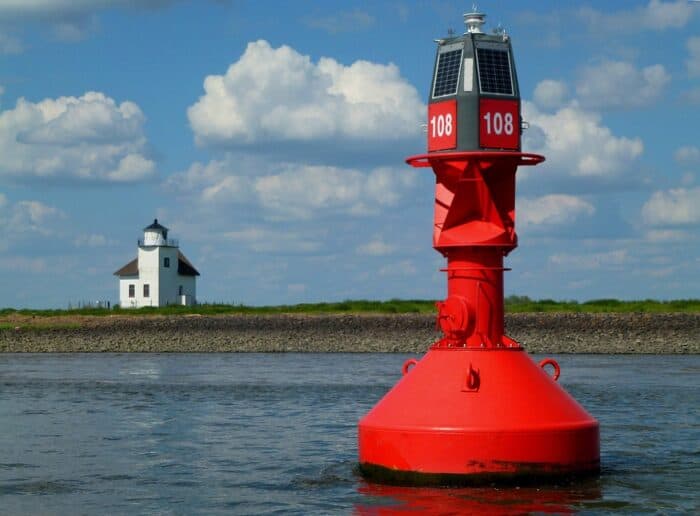What Do Lateral Markers Indicate?
The purpose of a lateral marker is to help you as a boater orient yourself safely on the water. They mark the edges of safe water on both the port and starboard sides of your vessel and they show you the safest or most preferred way of navigating in and out of an area.
It is unsafe to travel outside of the lateral markers as it’s possible they are not only indicating the preferred route but also warning of unseen dangers in the water outside of the marked path. This could include shallow waters, reefs or other obstacles and obstructions which could cause serious damage to a vessel.
What is a Lateral Marker?
Lateral markers act as crucial navigation aids by defining the boundaries of a channel. These markers typically appear in a pair: one green and one red, signifying the best route for a vessel. The green marker should be on your right side when you’re moving toward open water, while the red marker should be on your right as you head towards the channel.
There are actually six different kinds of lateral buoys and you’ll find them in both red and green. Green is meant to be on your port side while starboard is where the red is meant to be located. Here are the six kinds of markers you may run across out on the water.
- Port-Hand Buoys
- Starboard-Hand Buoys
- Port Bifurcation Buoys
- Starboard Bifurcation Buoys
- Fairway Buoys
- Isolated Danger Buoys
Port-Hand Buoys

As the name suggests, port-hand markers will be on your port or left said as you head upstream. They’re green and they feature numbers and letters. The numbers are odd digits and ascend as you head upstream. These are typically cylinder shaped buoys called can buoys and they may have green lights on top as well.
Starboard-Hand Buoys

On your right or starboard side, the starboard hand markers should look exactly the same as the port hand but they’ll be red instead of green. The numbers will be even instead of odd. These two types of markers indicate a safe path between them and to go outside of the buoys could present a serious danger to you and your vessel.
Port Bifurcation Buoys
A port bifurcation buoy is actually both red and green and shows where two channels intersect allowing you to pick your preferred channel. In this case the bulk of the buoy is green but there will be a center band of red. Technically you can pass this buoy to either side but whenever possible you want to pass it to port which is why it’s a port buoy.
Starboard Bifurcation Buoys
Similar to the port bifurcation buoy, this red and green buoy is chiefly red with a green band in the center. If possible, you want to pass this to the starboard side for the sake of safety and consistency.
Fairway Buoys

Fairway buoys are both red and white, there’s no green located on these ones. They can come in a variety of shapes as well including can buoys, ball buoys and more. They will be split red and white, however. Specifically it’s a white base with red, vertical striping. If the entire buoy isn’t a ball then you’ll see a ball on top of the buoy as well. Some of these buoys will also have a white flashing light on top. The light flashes ten times per minute in a sequence of one short flash followed by one longer flash.
The purpose of a fairway buoy is to indicate that you are about to enter a canal or safe approach into land. They can also be found in the center of channels and mean that you have unobstructed passage all around so you can safely pass on either side as you wish though it’s most common to pass them to the left or port side.
Isolated Danger Buoys
Like the name suggests, an isolated danger buoy is there to tell you about a single, isolated danger in the water. This could be something like a wreck or a rock which is located immediately under the buoy and needs to be avoided.
Isolated danger buoys are black with a red band in the center. There will be two black balls on top of the buoy as well. It may also have a flashing white light on top but it doesn’t have to. If there is a light it will flash a sequence of two quick flashes every four seconds.
Because it is moored above the danger, the water around the buoy is safe and navigable. You can pass to either side but give the buoy a good amount of space when passing in order to fully avoid the hidden danger.
What Do Non-Lateral Markers Indicate?

There are actually numerous non-lateral markers out there that contrast the lateral markers we have already covered. Essentially, if you see any marker that is not one of the lateral markers we’ve listed, that’s a non-lateral marker.
Remember, a lateral marker means it is lateral or to the side. So any marker that doesn’t indicate something to the side of the boat or tells you what side to pass on is a non-lateral marker. Some examples of non-lateral markers include:
- Control markers explaining rules
- Informational markers which may indicate locations and distances
- Hazard markers pointing out dangers
- Obstruction markers
- Swim markers showing swimming areas
- Cardinal buoys indicating dangers in a specific direction
What Do Red and Green Buoys Indicate?
Red and green colors are the standard colors for differentiating between directions on a boat and have been that way for some time. Even the lights on a boat correspond to this. Red always indicates port and green always indicates starboard. The reason for this is that the colors are easy to distinguish from one another and, because their use is consistent, it transcends language barriers so that every boater who sees red and green will always know what it means. You pass red to green when sailing so you keep the green buoys to port and red buoys to starboard.
What Lateral Marker Has a Blue Horizontal Band?

This unique marker is not a lateral marker at all. The blue horizontal band is found on a mooring marker which is white otherwise. This is the only kind of marker that you can tie your own vessel to. You can find these in marinas and you’ll often see something like a fishing boat attached to them.
What do the Numbers on a Lateral Marker Mean?
The numbers found on markers indicate the distance from the marker to the open sea. As you head upstream towards the shore the number will increase indicating that your distance from the open sea is increasing. If you’re heading out then obviously the numbers will decrease until you reach the end of the markers.
The Bottom Line
A lateral marker is designed to be to one side or the other of your vessel and they most often indicate the safest path for your vessel to travel. Because they are color coded red and green you know to keep the red markers to your left or port side and the green markers to your right or starboard side.
Lateral markers may come in various shapes and sizes and may also have lights on occasion but the meaning of every kind of marker is very specific. You should always pass around or through markers as the colors indicate.
Categories: Boats












1 Comment
Dorla on January 9, 2023
Very clear explanation. Much to be learned. I am considering purchasing a 30ft one now that I am retired. Thank you